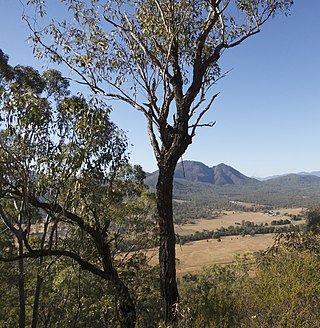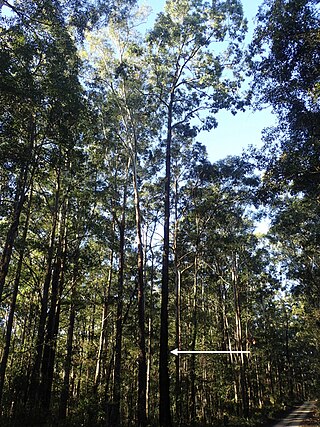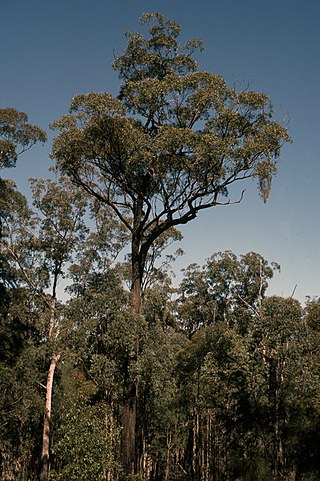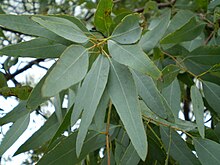
Eucalyptus punctata, commonly known as grey gum, is a small to medium-sized tree that is endemic to eastern Australia. It has smooth grey bark that is shed in patches, lance-shaped, curved or egg-shaped adult leaves flower buds in groups of seven, white flowers and hemispherical or cup-shaped fruit. Its leaves are one of the favoured foods of the koala.

Eucalyptus sideroxylon, commonly known as mugga ironbark, or red ironbark is a small to medium-sized tree that is endemic to eastern Australia. It has dark, deeply furrowed ironbark, lance-shaped adult leaves, flower buds in groups of seven, white, red, pink or creamy yellow flowers and cup-shaped to shortened spherical fruit.

Eucalyptus crebra, commonly known as the narrow-leaved ironbark, narrow-leaved red ironbark or simply ironbark, and as muggago in the indigenous Dharawal language, is a species of small to medium-sized tree endemic to eastern Australia. It has hard, rough "ironbark" from its trunk to small branches, linear to lance-shaped adult leaves, flower buds in groups of seven, nine or eleven, white flowers and cup-shaped, barrel-shaped or hemispherical fruit. A variable species, it grows in woodland and forest from the Cape York Peninsula to near Sydney. It is an important source of nectar in the honey industry and its hard, strong timber is used in construction.

Eucalyptus fibrosa, commonly known as the red ironbark, broad-leaved red ironbark or broad-leaved red ironbark, is a species of medium-sized to tall tree endemic to eastern Australia. It has grey to black ironbark, lance-shaped to egg-shaped adult leaves, flower buds in groups of between seven and eleven, white flowers and conical fruit.

Eucalyptus melanophloia, commonly known as silver-leaved ironbark, is a species of tree that is endemic to northeastern Australia. It is a small to medium-sized tree with rough, hard ironbark on the trunk and branches. The crown is usually composed of juvenile leaves that are dull, glaucous, sessile and arranged in opposite pairs. The flower buds are arranged in groups of seven, the flowers white and the fruit cup-shaped to hemispherical.

Corymbia citriodora, commonly known as lemon-scented gum and other common names, is a species of tall tree that is endemic to north-eastern Australia. It has smooth white to pink bark, narrow lance-shaped to curved adult leaves, flower buds in groups of three, white flowers and urn-shaped or barrel-shaped fruit.

Eucalyptus melliodora, commonly known as yellow box, honey box or yellow ironbark, is a species of medium-sized to occasionally tall tree that is endemic to south-eastern, continental Australia. It has rough, flaky or fibrous bark on part or all of the trunk, smooth greyish to yellowish bark above. The adult leaves are lance-shaped to egg-shaped, the flower buds are arranged in groups of seven and the fruit is more or less hemispherical.

Eucalyptus caleyi, commonly known as Caley's ironbark or Ovenden's ironbark is a species of small to medium-sized tree, endemic to eastern Australia. It has brown or black "ironbark" on the trunk and main branches, dull bluish grey lance-shaped to egg-shaped adult leaves, flower buds in groups of seven, white flowers and barrel-shaped or conical fruit. It grows on the Central and Northern Tablelands of New South Wales and in south-eastern Queensland.

Eucalyptus dura is a species of small to medium sized tree that is endemic to south-eastern Queensland. It has rough, dark grey to black "ironbark", lance-shaped adult leaves, flower buds in groups of seven, white flowers and conical fruit.

Eucalyptus fusiformis, commonly known as the grey ironbark or Nambucca ironbark is a tree that is endemic to eastern Australia. It has thick, blackish, "ironbark" on the trunk and branches, lance-shaped to curved adult leaves, flower buds in groups of seven, white flowers and conical to pear-shaped fruit.
Eucalyptus atrata, commonly known as the Herberton ironbark or blue-leaved ironbark, is a small tree that is endemic to Queensland. It has hard, black "ironbark" on the trunk and all but the thinnest branches, lance-shaped adult leaves, buds usually arranged in groups of seven, white flowers and cup-shaped to hemispherical fruit. It is characterised by the blue-grey, powdery bloom on its leaves and flower buds.
Eucalyptus chartaboma, commonly known as paperbark gum, is a eucalypt that is endemic to Queensland. It is a medium-sized tree with soft, papery, fibrous bark on the lower trunk, smooth white to pale cream-coloured bark above, lance-shaped adult leaves, flower buds in groups of seven, orange-coloured flowers and oval to urn-shaped fruit. The flower buds and fruit have distinct ribs along their sides.
Eucalyptus corynodes is a species of tree that is endemic to Queensland. It has hard, dark grey "ironbark", lance-shaped to curved adult leaves, flower buds usually on a branching inflorescence, the buds in groups of seven, white flowers and barrel-shaped to cup-shaped fruit.
Eucalyptus exilipes, commonly known as the fine-leaved ironbark, is a species of medium to tall tree and is endemic to Queensland. It has dark grey or black "ironbark", linear to narrow lance-shaped adult leaves, flower buds in groups of seven, white flowers and cup-shaped to shortened spherical fruit. It is similar to E. crebra, differing only in the length of the pedicels.

Eucalyptus melanoleuca, commonly known as yarraman ironbark or nanango ironbark, is a species of tree that is endemic to south-east Queensland. It has rough ironbark on the trunk and larger branches, smooth bark above, lance-shaped adult leaves, flower buds in groups of seven, white flowers and barrel-shaped, to cup-shaped or conical fruit.
Eucalyptus paedoglauca, commonly known as the Mount Stuart ironbark, is a small to medium-sized tree that is endemic to a small area in Queensland. It has rough, dark ironbark, lance-shaped adult leaves, flower buds in groups of seven, white flowers and cup-shaped fruit. It is only known from a few hills near Townsville.

Eucalyptus quadricostata, commonly known as the square-fruited ironbark, is a species of small to medium-sized ironbark that is endemic to Queensland. It has rough ironbark on the trunk and branches, lance-shaped to curved adult leaves, flower buds in groups of seven, white flowers and cup-shaped fruit that are square in cross-section.

Eucalyptus shirleyi, commonly known as Shirley's silver leafed ironbark, silver-leaved ironbark, or Shirley's silver leaved ironbark, is a species of small ironbark tree that is endemic to Queensland. It has rough ironbark on the trunk and larger branches, the thinnest branches glaucous, a crown composed of sessile, heart-shaped, egg-shaped or round juvenile leaves, flower buds in groups of seven, white flowers and cup-shaped to barrel-shaped fruit.

Eucalyptus taurina, commonly known as the Helidon ironbark, is a species of medium-sized to tall ironbark that is endemic to Queensland. It has rough ironbark on the trunk and sometimes the larger branches, smooth bark above, lance-shaped adult leaves, flower buds in groups of seven, white flowers and conical to hemispherical fruit.
Eucalyptus farinosa is a species of small tree that is endemic to Queensland. It has hard, dark grey ironbark, egg-shaped to lance-shaped adult leaves, flower buds in groups of seven, white flowers and cup-shaped to barrel-shaped and ribbed fruit.














